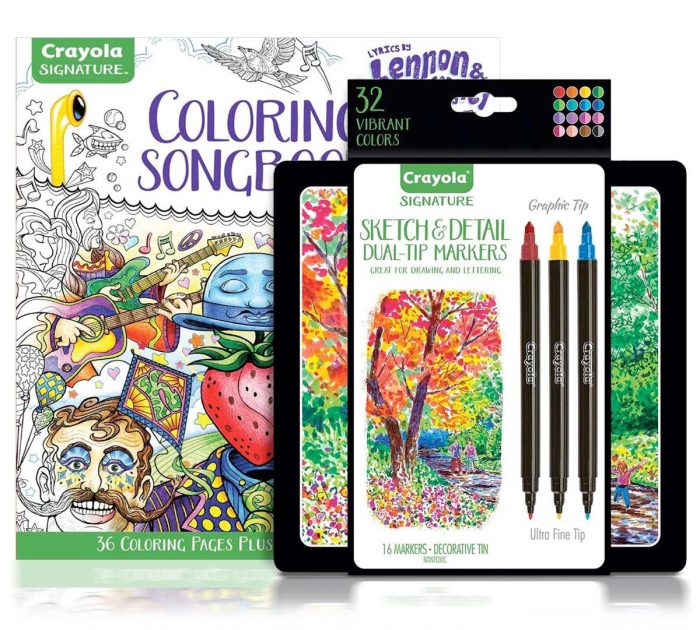Popularity and Trends
Coloring books with markers – Coloring books for adults and children, paired with markers, have experienced a significant surge in popularity in recent years, transforming from a niche hobby into a mainstream creative outlet. This trend reflects a growing interest in mindfulness, stress reduction, and creative expression. The market is dynamic, with continuous evolution in design, materials, and marketing strategies.
Current Market Trends for Coloring Books and Markers
The market shows a strong preference for intricate designs and detailed illustrations. Mandala patterns, floral motifs, and nature-inspired themes remain consistently popular. There’s also a growing demand for coloring books tailored to specific interests, such as animals, fantasy art, and geometric patterns. Simultaneously, marker trends lean towards vibrant, high-pigment inks, dual-tipped markers offering both fine and broad lines, and alcohol-based markers for their smooth blending capabilities.
The emphasis is on high-quality materials that provide a satisfying user experience.
The vibrant hues achievable with markers significantly enhance the coloring book experience, allowing for bold outlines and rich shading. A prime example of a title that benefits from this technique is the lightning mcqueen coloring book , where the character’s iconic red paint job truly comes alive with marker application. Ultimately, the choice of medium, like markers, profoundly impacts the final aesthetic of any coloring book project.
Top-Selling Coloring Book Styles Paired with Markers
Intricate adult coloring books featuring detailed designs are consistently among the top sellers. These often pair well with alcohol-based markers, allowing for smooth blending and layering of colors. Children’s coloring books featuring popular characters or themes also perform strongly, often utilized with water-based markers due to their ease of use and clean-up. Books with simple designs, perfect for beginners, also see considerable sales, often paired with a variety of marker types depending on user preference.
Sales Data Comparison of Different Marker Types
While precise sales figures are often proprietary, market observations indicate a strong preference for alcohol-based markers among experienced colorists, due to their rich colors and blending capabilities. These markers tend to command higher price points but offer superior performance. Water-based markers dominate the children’s market due to their affordability, ease of use, and non-toxic nature. Sales data suggest a growing market segment for dual-tipped markers, which offer versatility for both fine details and broad coloring.
Market Data Summary, Coloring books with markers
| Category | Trend | Sales Data (Illustrative) | Notable Brands |
|---|---|---|---|
| Adult Coloring Books | Intricate designs, mandala patterns | High sales volume, increasing year-on-year | Various independent artists, Dover Publications |
| Children’s Coloring Books | Popular characters, simple designs | High sales volume, consistent demand | Disney, Nickelodeon, Crayola |
| Alcohol-Based Markers | High pigment, smooth blending | Strong growth in the adult market | Copic, Prismacolor |
| Water-Based Markers | Ease of use, affordability | Dominates the children’s market | Crayola, Sakura |
| Dual-tipped Markers | Versatility, fine and broad lines | Growing market segment | Tombow, Pentel |
Types of Coloring Books and Markers

Choosing the right coloring book and markers can greatly enhance your creative experience. The variety available allows you to find the perfect tools to match your skill level and preferred style, leading to hours of enjoyable and relaxing coloring. Let’s explore the different options.
Coloring Book Designs
Coloring books cater to a wide range of preferences. Intricate designs, often featuring detailed mandalas or complex illustrations of animals or nature scenes, offer a challenge for experienced colorists and provide a sense of accomplishment upon completion. Simpler designs, such as those with large, bold shapes and fewer details, are ideal for beginners or those looking for a more relaxed coloring experience.
Themed coloring books, focused on specific interests like animals, fantasy, or holidays, allow for personalized creativity and cater to individual passions. Each type provides a unique creative outlet.
Marker Types
Several marker types offer distinct characteristics. Brush tip markers provide versatility, allowing for both broad strokes and fine details depending on pressure. Fine liner markers are perfect for precise work, ideal for adding small details or creating Artikels. Dual tip markers combine the best of both worlds, offering both a fine tip and a broader brush tip in a single pen, providing maximum flexibility.
Marker Ink Properties and Paper Types
Different marker inks have varying properties that affect their performance on different paper types. Alcohol-based markers, known for their vibrant colors and quick drying time, tend to bleed through thinner papers. Water-based markers, while less vibrant, are generally better suited for thinner papers as they are less likely to bleed. Heavier weight paper, such as cardstock, is recommended for all marker types to prevent bleed-through and feathering.
The choice of paper significantly impacts the final result, with heavier paper offering better control and a cleaner look.
Marker Type Comparison
Understanding the advantages and disadvantages of each marker type is crucial for selecting the right tool.
- Brush Tip Markers:
- Advantages: Versatile, allows for varied line weights, creates expressive strokes.
- Disadvantages: Can be harder to control for fine details, may require more practice.
- Fine Liner Markers:
- Advantages: Precise lines, excellent for detail work, consistent line weight.
- Disadvantages: Less versatile for broader strokes, can be tedious for large areas.
- Dual Tip Markers:
- Advantages: Combines versatility and precision, offers both broad and fine strokes in one pen.
- Disadvantages: Can be more expensive than single-tip markers.
User Experience and Techniques

Unleash your creativity and bring your coloring pages to life! This section explores effective techniques for using markers in coloring books, offering tips and tricks to enhance your artistic expression. We’ll delve into the importance of paper quality and provide a step-by-step guide to help you master the art of marker coloring.
The joy of coloring lies in the process of transforming a blank page into a vibrant work of art. Marker coloring, in particular, offers a unique blend of control and fluidity, allowing for both precise detail and expressive washes of color. Understanding a few key techniques can elevate your coloring experience from enjoyable to truly rewarding.
Effective Coloring Techniques
Mastering marker techniques opens up a world of creative possibilities. From delicate shading to bold color blocking, different approaches produce strikingly different results. Experimentation is key to discovering your preferred style.
For example, layering colors allows you to create depth and richness. Start with lighter shades as your base, gradually building up intensity with darker colors. Blending involves smoothly transitioning between colors, often achieved by using a light touch and overlapping strokes. This technique can create soft gradients and realistic textures. Shading, on the other hand, involves using darker tones to create the illusion of depth and dimension, adding realism to your subjects.
Consider the light source and how it affects the object you’re coloring to guide your shading.
Achieving Different Effects with Markers
The versatility of markers allows for a wide range of effects. Light pressure creates delicate lines, while firm pressure results in bold, saturated strokes. Varying pressure within a single stroke can create interesting textural effects. Experiment with different marker types—fine-tipped markers for details and broad-tipped markers for larger areas—to achieve a variety of looks.
Techniques like stippling (creating patterns using small dots), hatching (using parallel lines), and cross-hatching (using intersecting lines) can be used to create textures and add visual interest. These techniques can be used independently or in combination to create complex and dynamic coloring effects.
The Importance of Paper Quality
The paper you choose significantly impacts the final result of your marker coloring. Thick, high-quality paper is crucial for preventing bleed-through and feathering, which can ruin the details and overall aesthetic appeal of your artwork. Thinner paper will often allow the marker ink to bleed through to the other side, creating a messy result. Furthermore, the paper’s surface texture can influence the way the markers apply, with smoother papers allowing for smoother blending and finer details.
For example, using marker-specific paper designed for alcohol-based markers prevents bleed-through and ensures vibrant, consistent color. Using standard printer paper with alcohol-based markers, on the other hand, can lead to unpleasant feathering and a lack of color vibrancy.
Step-by-Step Guide: Coloring a Flower
Let’s create a simple flower using markers. This guide demonstrates layering and shading techniques.
- Sketching: Lightly sketch the Artikel of a flower and its petals on your marker paper. Keep the lines light so they’re easily erased or hidden by the marker colors.
- Base Colors: Use light yellow for the center of the flower and a light pink for the petals. Apply a single layer, ensuring even coverage.
- Layering and Shading: Add a darker yellow to the center of the flower, creating a gradient effect. Similarly, use a darker pink for the outer edges of the petals and a slightly darker shade in the shadows.
- Highlighting: Add small touches of a very light yellow to the center of the flower and a very light pink to the tips of the petals to create highlights. This enhances the three-dimensionality of the flower.
- Details: Use a fine-tipped marker to add details like veins in the petals and texture to the center.
Essential FAQs: Coloring Books With Markers
What type of paper is best for markers in coloring books?
Thicker paper, ideally at least 110lb/160gsm, is crucial to prevent bleed-through and feathering. Look for paper specifically designed for markers.
Can I use alcohol markers on regular coloring book paper?
Generally, no. Alcohol markers are highly pigmented and will likely bleed through standard coloring book paper. Use thicker paper designed for alcohol-based inks.
How do I clean markers after use?
Always recap markers immediately after use. For stubborn stains, use a damp cloth or marker cleaner specific to the ink type.
Are there coloring books specifically designed for markers?
Yes! Many coloring books are now marketed specifically for use with markers, featuring thicker paper and designs suitable for marker techniques.

